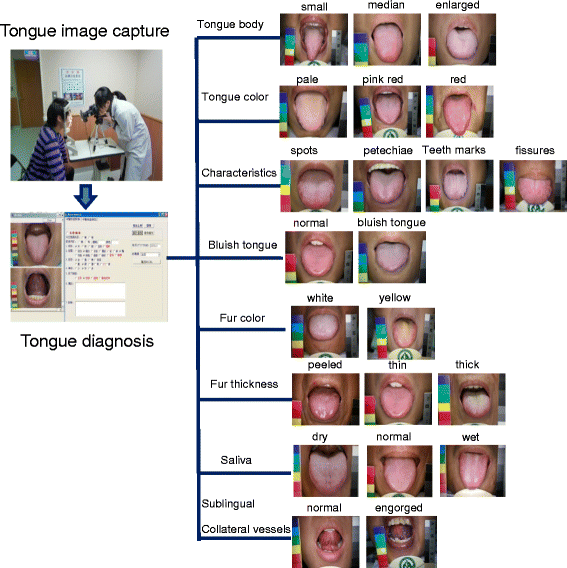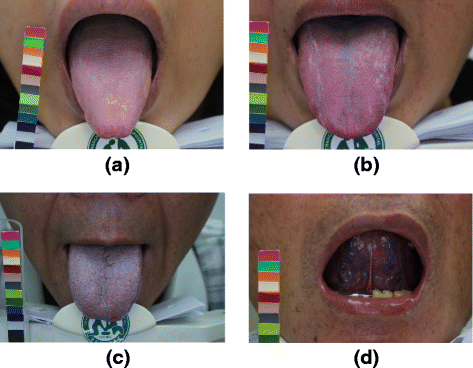The association between arterial stiffness and tongue manifestations of blood stasis in patients with type 2 diabetes
- PMID: 27567605
- PMCID: PMC5002208
- DOI: 10.1186/s12906-016-1308-5
The association between arterial stiffness and tongue manifestations of blood stasis in patients with type 2 diabetes
Abstract
Background: Diabetes mellitus (DM) is a hypercoagulable state and is associated with highly increased risk of vascular complications. In the theory of traditional Chinese medicine (TCM), these vascular complications are classified as blood stasis. Diagnosis of the tongue plays an important role in TCM; a bluish tongue, petechiae, and engorged sublingual collateral vessels are manifestations of blood stasis. This study aimed to characterize the tongue manifestations of blood stasis and derive a relationship between blood stasis and vascular disorders in patients with type 2 DM.
Method: We conducted a cross-sectional study of 140 patients with type 2 DM, and compared demography, laboratory, physical examination, ankle brachial index(ABI), brachial-ankle pulse wave velocity (ba-PWV), and tongue manifestation datas. An automatic tongue diagnosis system was used to capture tongue images and characterize clinical tongue manifestations.
Results: A bluish or petechiae tongue was assoicated with a significant decrease in high-density lipoprotein level, and bluish tongue was associated with significant increase in blood triglyceride in patients with type 2 DM. On assessing arterial stiffness, patients with a petechiae tongue had a higher ba-PWV for both sides (L:1938.41 ± 469.54 cm/sec v.s.1723.99 ± 302.16, p = 0.02; R:1937.28 ± 405.55 v.s.1741.99 ± 325.82, p = 0.03).
Conclusion: Blood stasis, particularly a tongue with petechiae, may be associated with arterial stiffness in patients with type 2 DM. Furthermore, tongue diagnosis could detect blood stasis relevant to DM and could serve as a feasible predictor for DM.
Keywords: Arterial stiffness,and brachial-ankle pulse wave velocity (ba-PWV); Blood stasis; Diabetes mellitus (DM); Tongue diagnosis; Traditional Chinese medicine (TCM).
Figures
Similar articles
-
The performance of lipid profiles and ratios as a predictor of arterial stiffness measured by brachial-ankle pulse wave velocity in type 2 diabetic patients.F1000Res. 2023 Jun 5;11:1582. doi: 10.12688/f1000research.128627.2. eCollection 2022. F1000Res. 2023. PMID: 39221025 Free PMC article.
-
Is visceral adiposity a modifier for the impact of blood pressure on arterial stiffness and albuminuria in patients with type 2 diabetes?Cardiovasc Diabetol. 2016 Jan 21;15:10. doi: 10.1186/s12933-016-0335-3. Cardiovasc Diabetol. 2016. PMID: 26790628 Free PMC article.
-
Low-grade albuminuria associated with brachial-ankle pulse wave velocity in young adults with type 2 diabetes mellitus in China.Diabetes Metab Res Rev. 2015 Mar;31(3):262-8. doi: 10.1002/dmrr.2598. Epub 2014 Oct 18. Diabetes Metab Res Rev. 2015. PMID: 25139614
-
From Xiaoke to diabetes mellitus: a review of the research progress in traditional Chinese medicine for diabetes mellitus treatment.Chin Med. 2023 Jun 22;18(1):75. doi: 10.1186/s13020-023-00783-z. Chin Med. 2023. PMID: 37349778 Free PMC article. Review.
-
Diabetes Mellitus, Cognitive Impairment, and Traditional Chinese Medicine.Int J Endocrinol. 2015;2015:810439. doi: 10.1155/2015/810439. Epub 2015 Apr 28. Int J Endocrinol. 2015. PMID: 26060494 Free PMC article. Review.
Cited by
-
Deep Learning Multi-label Tongue Image Analysis and Its Application in a Population Undergoing Routine Medical Checkup.Evid Based Complement Alternat Med. 2022 Sep 29;2022:3384209. doi: 10.1155/2022/3384209. eCollection 2022. Evid Based Complement Alternat Med. 2022. PMID: 36212950 Free PMC article.
-
A Perspective on Tongue Diagnosis in Patients with Breast Cancer.Evid Based Complement Alternat Med. 2021 Dec 26;2021:4441192. doi: 10.1155/2021/4441192. eCollection 2021. Evid Based Complement Alternat Med. 2021. PMID: 34987592 Free PMC article.
-
Panoramic tongue imaging and deep convolutional machine learning model for diabetes diagnosis in humans.Sci Rep. 2022 Jan 7;12(1):186. doi: 10.1038/s41598-021-03879-4. Sci Rep. 2022. PMID: 34996986 Free PMC article.
-
Tongue diagnosis indices for upper gastrointestinal disorders: Protocol for a cross-sectional, case-controlled observational study.Medicine (Baltimore). 2018 Jan;97(2):e9607. doi: 10.1097/MD.0000000000009607. Medicine (Baltimore). 2018. PMID: 29480863 Free PMC article.
-
Gender- and age-dependent tongue features in a community-based population.Medicine (Baltimore). 2019 Dec;98(51):e18350. doi: 10.1097/MD.0000000000018350. Medicine (Baltimore). 2019. PMID: 31860990 Free PMC article.
References
MeSH terms
LinkOut - more resources
Full Text Sources
Other Literature Sources
Medical



